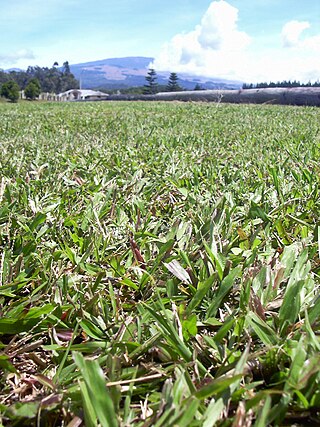
Alopecurus, or foxtail grass, is a common and widespread genus of plants in the grass family. It is common across temperate and subtropical parts of Eurasia, northern Africa, and the Americas, as well as naturalized in Australia and on various islands.

Agrostis is a large and very nearly cosmopolitan genus of plants in the grass family, found in nearly all the countries in the world. It has been bred as a GMO creeping bent grass.

Agrostis stolonifera is a perennial grass species in the family Poaceae.

Phleum (timothy) is a genus of annual and perennial plants in the grass family. The genus is native to Europe, Asia and north Africa, with one species also in North and South America.

Axonopus compressus is a species of grass. It is often used as a permanent pasture, groundcover, and turf in moist, low fertility soils, particularly in shaded situations. It is generally too low-growing to be useful in cut-and-carry systems or for fodder conservation.

Polypogon is a nearly cosmopolitan genus of plants in the grass family, commonly known beard grass or rabbitsfoot grass.
Chaetopogon is a genus of European plants in the grass family.

Polypogon monspeliensis, commonly known as annual beard-grass or annual rabbitsfoot grass, is a species of grass. It is native to the Old World, but it can be found today throughout the world as an introduced species and sometimes a noxious weed. It is an annual grass growing to heights between 5 centimeters and one meter. The soft, fluffy inflorescence is a dense, greenish, plumelike panicle, sometimes divided into lobes. The spikelets have long, thin, whitish awns, which give the inflorescence its texture.

Najas guadalupensis is a species of aquatic plant known by the common names southern waternymph, guppy grass, najas grass, and common water nymph. It is native to the Americas, where it is widespread. It is considered native to Canada, and most of the contiguous United States, Mexico, Central America, the West Indies and South America. It has been introduced in Japan, Israel and Palestine.

Polypogon australis is a species of grass known by the common names Chilean beard grass and Chilean rabbitsfoot grass. It is native to Chile and Argentina. It is also known in parts of the western United States where it is an introduced species and invasive species that grows in moist habitat types such as ditches.

Polypogon maritimus is a species of grass known by the common names Mediterranean beard grass and Mediterranean rabbitsfoot grass. It is native to the Mediterranean Basin. It is also known in other parts of the world, including Australia, New Zealand, and the United States, as an introduced species that can be found in moist habitat types. It is an annual grass producing stems up to half a meter tall. The inflorescence is a plumelike panicle up to 15 centimeters long containing many V-shaped spikelets with long awns.

Potamogeton compressus is a species of aquatic plant known by the common names grass-wrack pondweed, flatstem pondweed and eel-grass pondweed.
Interruptus may refer to:

Muhlenbergia glomerata is a species of grass known as spiked muhly and marsh muhly. It is native to North America, where it occurs across Canada and the northern half of the United States.

Panicum repens is a species of grass known by many common names, including torpedo grass, creeping panic, panic rampant, couch panicum, wainaku grass, quack grass, dog-tooth grass, and bullet grass. Its exact native range is obscure. Sources suggest that the grass is native to "Africa and/or Asia", "Europe or Australia", "Eurasia", "Australia", "Europe, Asia, and Africa", or other specific regions, including the Mediterranean, Israel, and Argentina. It is present in many places as an introduced species and often a noxious weed. It has been called "one of the world's worst weeds."

Elymus wawawaiensis is a species of grass known by the common name Snake River wheatgrass. It is native to western North America, where it occurs in the Pacific Northwest. It is native to eastern Washington and Oregon and parts of Idaho.

Paspalum floridanum is a species of grass known by the common name Florida paspalum. It is native to the eastern United States.

Brachiaria mutica is a species of grass known by the common names para grass, buffalo grass, Mauritius signal grass, pasto pare, malojilla, gramalote, parana, Carib grass, and Scotch grass. Despite its common name California grass, it does not occur in California; it is native to northern and central Africa and parts of the Middle East, where it is cultivated for fodder. It was introduced elsewhere and it is now cultivated throughout tropical regions of the world for this purpose.
Polypogon maritimus, the Mediterranean rabbitsfoot grass, is a species of annual herb in the family Poaceae. They have a self-supporting growth form. Individuals can grow to 0.17 m.

Polypogon viridis, the beardless rabbitsfoot grass, is a species of perennial grass in the family Poaceae. They have a self-supporting growth form and simple, broad leaves. Individuals can grow to 0.43 m. They are native to southern Europe, Macaronesia, North and East Africa, and Asia.

















